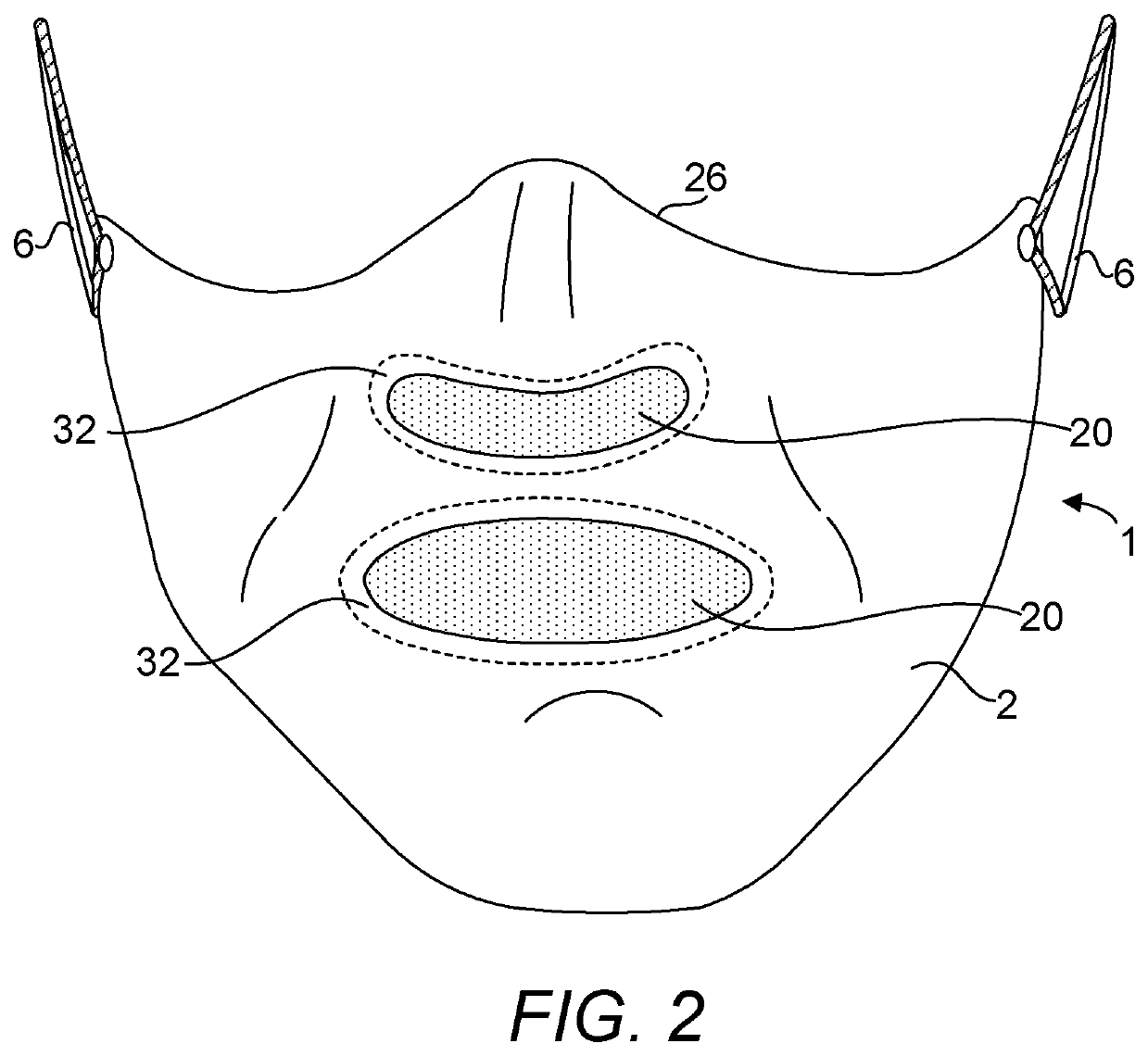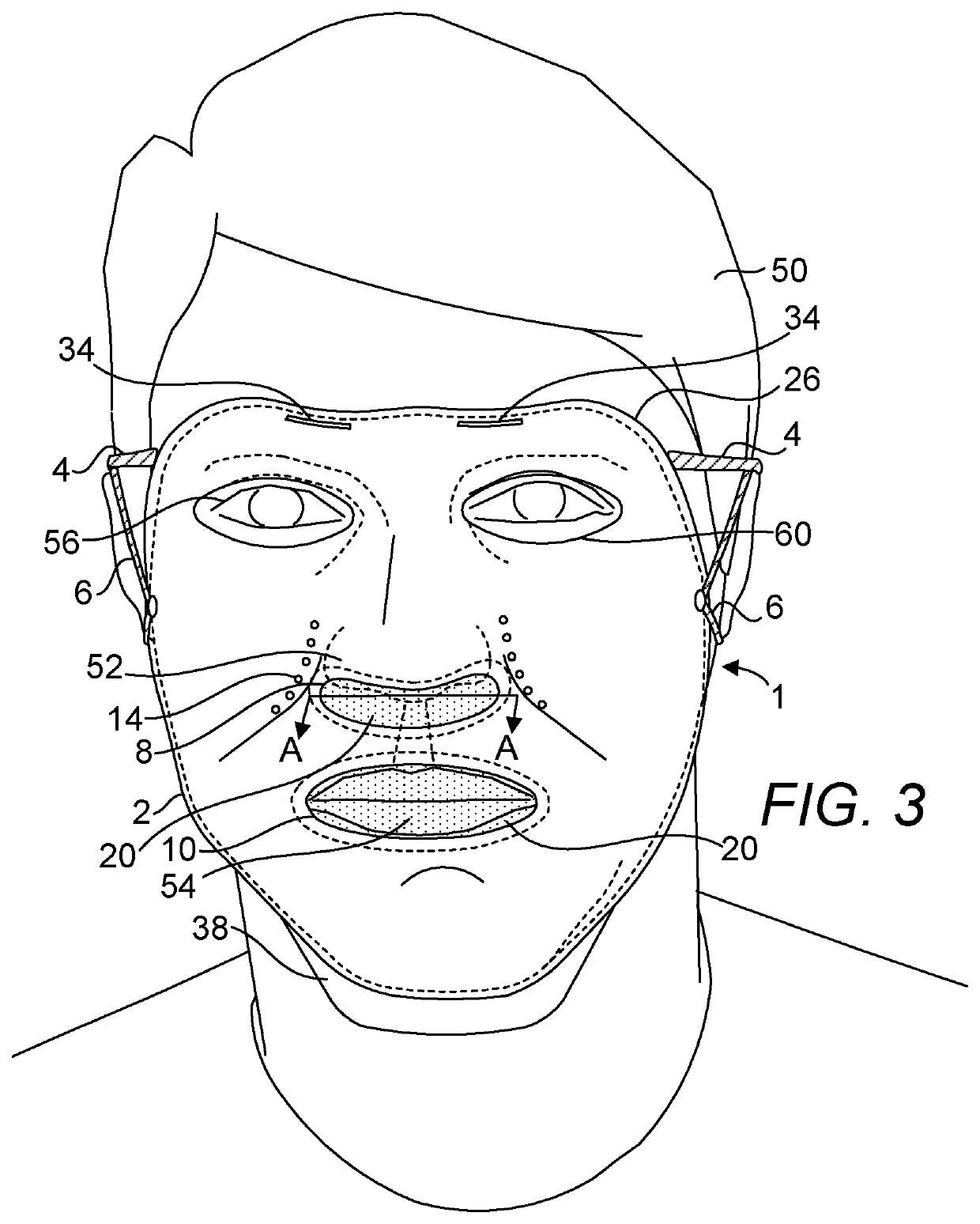This causes the filter to flex excessively and vibrate at a
low frequency of about 70 Hz.
Blowout breaches to the side and back of the mask can occur when a user is
breathing out, significantly impacting protection to others.
Water vapor can build up in the face mask, quickly affecting the transmissivity of
oxygen, causing difficulty in breathing and loss of filtering.
Persons may transmit the
virus when not exhibiting symptoms and as such
asymptomatic transmission has been difficult to identify.
In addition, it has been found to be fatal in young people and passed on to unborn children.
The
virus has also been shown to mutate, quickly raising concerns about second wave of exposures.
Current mask designs and mask materials offer limited protection, allow spreading to occur and have multiple adverse side effects.
For instance, the added plastic shields on one's face can cause
skin skiving and scarring over time, as well as eyeglasses
fogging up.
To date, although a number of mask designs have evolved, they are however still not adequately addressing most shortcomings, especially air flow dynamics within the mask, virus breach of the mask and the lack of
eye protection.
Current mask designs inadequately protect one's nose and mouth and most offer no protection for eyes, the organ in the body having the 2nd highest percentage of water.
Those that do offer some protection
impact the eyesight of their users and
fog up.
Slippages due to manual tying of cloth bands, the inability to keep tight, the need for another person to do the tying all contribute to the lack of acceptance of prior art
face masks or face shields.
Further, cross
contamination occurs from mask to hands during mask removal.
Plastic shields can rub into soft
facial skin and can cause
open wounds and scarring when health officials use them for multiple hours at a time.
Due to the size of the virus, the
filter material is dense and it is not readily permeable to air flow.
As such, when breathing out, the filter membrane flexes out, creates blowout leakage around the sides of the mask, and up under glasses causing
fogging.
When breathing in, the filter membrane gets sucked in toward the mouth and nose causing difficulty in breathing through
water vapor saturated areas of the filter.
Thus, the filter membrane flexes back and forth like a sound speaker at
low frequency, affecting the effectiveness of the filter.
Difficulty in breathing causes one to breath harder, further exasperating the problems above.
Some prior art masks are single-use masks that result in a tremendous amount of wastes.
Further, there are expensive filter materials are very large and not strategically used.
Yet further, most
face masks are for single uses and none are re-useable or recyclable.
Those that are reusable are made of
silicone which is not sustainable or even recyclable.
Prior art masks create a safety issue as the majority of a person's face is covered.
As the face of a user is at least partially covered with a mask, a suspect or criminal may not be easily identified based upon facial recognition upon committing a crime.
Prior art masks are made solely for a
single application, e.g., to reduce the transmission of COVID-19, these masks are not easily converted to for use as
allergy or second-hand
smoke filter masks.
Current attempts at shielding eyes require a secondary large
wrap around plastic shielding, thus doubling the difficulty in attachment to the head, requiring two people to attach, creates excessive glare, and eye strain, and do not protect from a rear entry of air flow carrying viruses, e.g., due to a
sneeze from behind or air turbulence from
contaminated air circulation fan,
air conditioning or wind.
This concept is not useable for existing eye glass wearers.
However, none of the
face masks and protective devices provide adequate protection, comfort and effectiveness against the highly communicable COVID-19.
There are concerns over the durability of the glue used due to sweating, sunscreen and stresses exerted during the use of the mask, e.g., talking of the user, etc.
Any extension of the
silicone materials over eyes is not practical due to optical
impact of the
silicone to the user.
Silicone outgases over long periods of time.
However, there are concerns that the user of a dishwasher can cause cross
contamination of the virus into the dishwasher and subsequently onto dishes used in subsequent use of the dishes.
An extension of silicone over eyes is not practical due to the
impact on the lack of
visibility when silicone is used.
 Login to View More
Login to View More  Login to View More
Login to View More 


